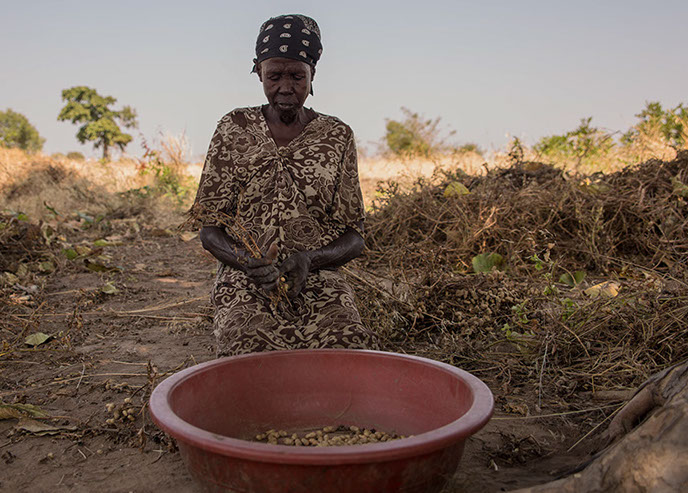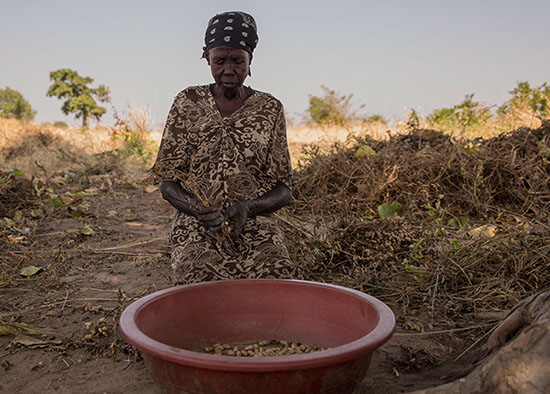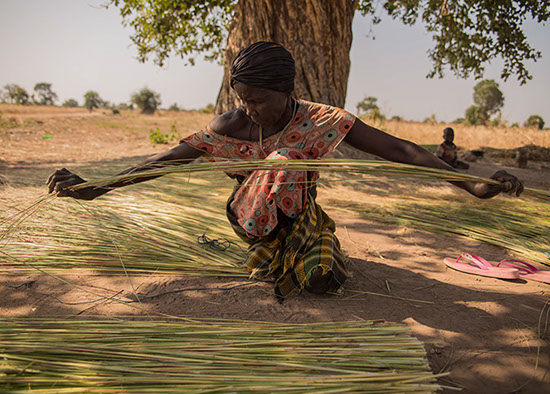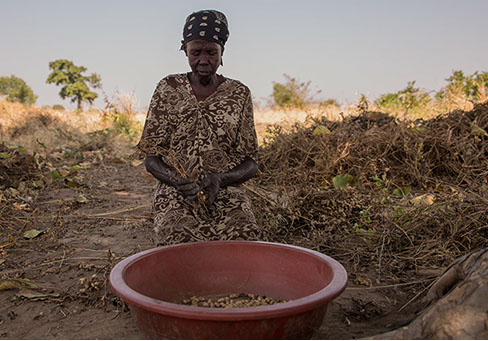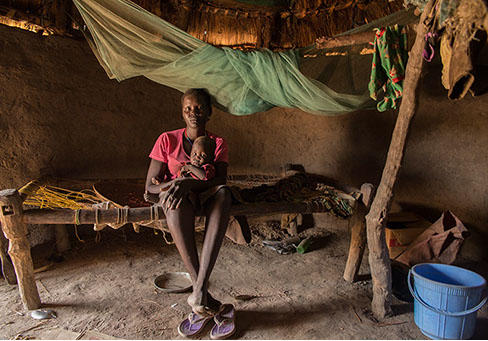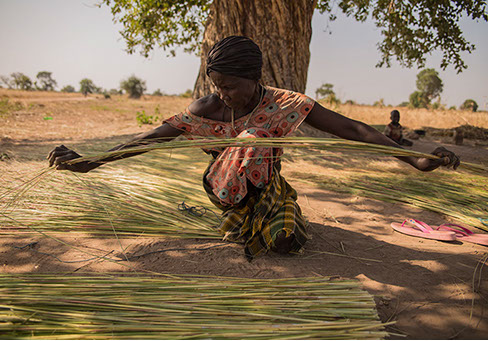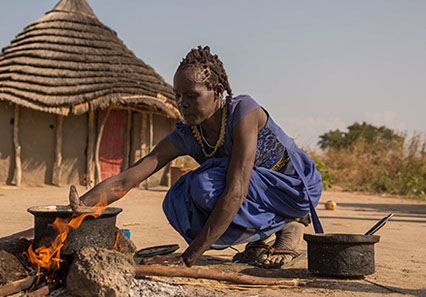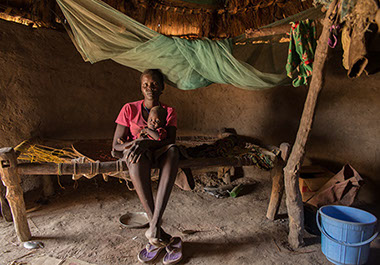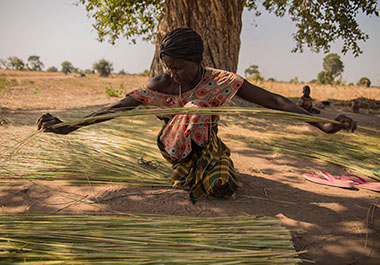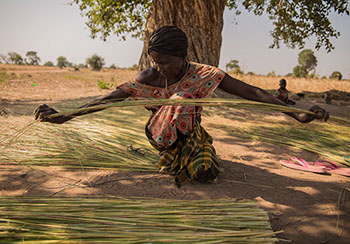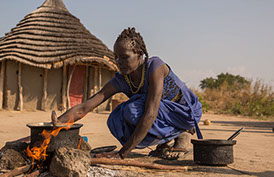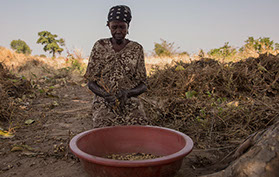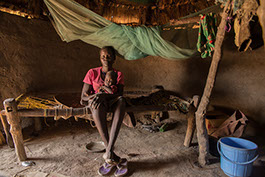Food aid 2018:
the never-ending crisis
The rise in man-made, protracted emergencies means millions are at risk of starving around the globe this year
Countries in crisis
Click to see funding needs

It’s a difficult new year for the humanitarian system and those reliant on it: a near-record number of people are in need and yet a yawning funding gap will limit what assistance can be provided.
According to the UN’s Global Humanitarian Overview for 2018, some $22.5 billion in aid will be required in the coming year to help 90.9 million of the 135.7 million vulnerable people in need of assistance and protection.
Funding can’t keep pace with need, so where are the biggest gaps and which groups are missing out most? This special IRIN report focuses on those who are most food insecure – those on the frontline of humanitarian emergencies who don’t know where their next meal is coming from.
The common driver in most of the food crises around the globe is conflict.
Today, around 80 percent of every dollar spent by the World Food Programme goes to operations in war zones.
This has some aid workers wondering if the funding tap will remain on in wealthy countries, where voters may cool to financing seemingly endless operations in countries beset by intractable man-made problems.
Donors lose appetite for North Korean food aid
Read more
To what extent should you help a regime willing to starve its own citizens to build missiles?
by Irwin Loy
After a year of nuclear threats, fiery brinksmanship, and retaliatory sanctions, the global aid sector is at a crossroads with North Korea.
There’s a question mark hovering over the immediate future of aid delivery as food assistance – once a symbolic thread of engagement with North Korea – has become wrapped up in red tape and is starting to weigh heavily on weary donors.
Dwindling funds forced the World Food Programme to claw back nutrition programmes for some 190,000 children in November. And this came after the UN organisation had already shrunk its food rations to the bare minimum required to have any nutritional impact whatsoever.
The WFP says it desperately needs $14.25 million to restock its shelves and deliver aid through the winter. But a turbulent year filled with nuclear bluster may have exhausted any lingering goodwill among most international donors. Both donors and aid groups now face a mounting ethical debate – and a potential public relations catastrophe – when engaging with volatile North Korea.
Balancing act
Delivering aid to North Korea has always been an ethical conundrum for donor governments and aid organisations.
Over the years, aid has helped to feed millions in a country where crippling drought, floods, and harsh winters exacerbate already precarious conditions. But North Korea’s own policies and economic mismanagement have also fuelled its shortages and starved its own population.
Today, access to food in North Korea remains haphazard and glaringly unequal. Tomás Ojea Quintana, the UN’s special rapporteur for rights in North Korea, told the UN General Assembly that the country’s public food distribution system still amounts to “discriminatory and unequal access to food, with many people either left out of the system or given irregular rations”.
Aid groups face heavy restrictions – a major problem in a country that has in the past been accused of diverting food aid. In 2006, North Korea’s government forced the WFP to slash its programmes. The number of international staff was reduced to 10 people based in Pyongyang, and the government reportedly refused to allow the WFP to employ Korean speakers, hampering the organisation’s ability to monitor aid.
“We have negotiated the best possible terms under the circumstances,” Anthony Banbury, then a WFP regional director, said at the time.
And while large parts of the population go undernourished, Pyongyang continues to pour money into its nuclear arsenal. Marcus Noland, director of studies at the Washington-based Peterson Institute for International Economics, points out that the money Pyongyang would need to close its food gap is “a pretty trivial sum” compared to its defence budget.
Years of these contradictions have left donor governments wary – and aid groups like the WFP with gaping shortfalls.
“It's a pretty complicated and discouraging story of provision of aid over a long period of time: less than completely sincere behaviour on both sides of the equation, questionable results, and now a situation where everybody is just sort of fed up,” Noland told IRIN. “And so there's not a lot of goodwill left.”
Aid’s ebb and flow
But for more than two decades, WFP food aid has been a rare avenue for the global community to engage with North Korea. The WFP began working in the country in 1995, as a devastating famine was taking hold. Hundreds of thousands of people – and possibly more – likely starved to death.
In the ensuing years, the international community has sent a wavering but sizeable stream of humanitarian aid flowing in as North Korea lurched between belligerence and more food shortages.
But these funds have ebbed as donor fatigue set in. The United States, which had forked out more than $1.3 billion in aid for North Korea since 1995, effectively stopped assistance in 2009 (though the administration of then-US president Barack Obama quietly earmarked a modest $1 million contribution to UNICEF in January 2017, two days before Donald Trump took office).
Today, UN-wide appeals for North Korea are chronically underfunded. Only seven individual governments, led by Russia and Switzerland, have contributed to the UN’s $113.5-million ask for 2017; together, these seven countries have pledged less than $13 million.
And new rounds of sanctions that inevitably follow North Korea’s escalating missile tests have made delivering humanitarian aid even more uncertain.
Sanctions have disrupted the banking channels aid groups rely on to access funds, forcing long delays or cancellations of key projects. Quintana said sanctions have prevented the import of chemotherapy medication and equipment for people with disabilities. While the restrictions weren’t intended to block humanitarian aid – the Security Council took the unusual step of issuing a press release to “clarify” the matter in December – they have magnified the hurdles for aid groups.
The WFP says more than 10 million North Koreans – 40 percent of the country – are likely undernourished. But after another year of cuts, the WFP’s cupboards are quickly emptying.
“Any further decrease in funding due to the current political situation will significantly affect WFP’s ability to continue… lifesaving interventions,” the organisation stated in August.
2018 is likely to prove to be another tough year, for groups like the WFP but especially for the children and pregnant women who make up the majority of its beneficiaries.
As political pressure builds and the cavernous funding gap swells, Noland says aid groups could be debating whether the risks of operating in North Korea are worth it.
“I think it's going to be very tough sledding for them,” he said.
(PHOTO: A flooded rice crop in Hamhung, North Korea. CREDIT: Kisan Gunjal/FAO)
x
In early 2017, WFP identified four countries – Nigeria, Yemen, South Sudan and Somalia – where famine loomed for more than 20 million people, impoverished and displaced by their respective wars.
“Donors, I think, clearly understand that it is much more cost effective to prevent famine than it is to deal with the extreme mortality that happens when a famine is actually declared,” said Peter Smerdon, East African spokesperson for WFP.
Yemen: “If the war doesn’t kill us, the food prices will”
Read more
The worst thing about Yemen's food crisis is that it's entirely manmade
By Nasser Al-Sakkaf and Annie Slemrod
Three-year-old Walid sits on a hospital bed, his bones and veins visible through his skin, tugging at the intravenous drip that is keeping him alive.
He’s one of only five kids being treated for malnutrition at a hospital in the Yemeni city of Taiz. It’s not that more children don’t need help – both Taiz City and the wider province have been hard hit by what the UN calls the worst humanitarian crisis in the world – but treatment (or even transport to the doctor) costs money that many in Yemen no longer have.
Walid was born only a few months before Yemen’s war broke out in March 2015. His father lost his job soon after. Sitting near her emaciated son, Walid’s mother Hindia says her family has struggled to buy enough food since the fighting broke out, and she was undernourished while nursing her son.
“I told my husband that Walid was hungry, but he couldn’t help because the price of formula was [so] high,” she explains. “Walid has been suffering since his birth.”
So while Yemen’s hunger crisis began finally making headlines in November as a Saudi Arabian-led coalition closed borders, ports, and airports in response to a Houthi rocket attack on Riyadh – warnings of famine and pictures of emaciated children like Walid made the front pages –
Hindia knows first-hand that Yemen has been slowly crashing towards catastrophe for years.
Eighteen million Yemenis in a country of more than 29 million are now classified as “food insecure”, with nearly 400,000 children in a state of “severe acute malnutrition”. And with a new battle looming, the prospects for millions of Yemenis – including young Walid – are bleak.
On this occasion, Hindia eventually found a wealthy family from her village to pay for her son’s treatment, but she is really worried about his future: “Next time, I might not,” she tells IRIN. “Walid could die at any time.”
Economy
Yemen’s war is complicated. It has been marked by a number of shifting alliances and dramatic events, such as the 4 December death of former president Ali Abdullah Saleh.
During his 30 years of power, Saleh often battled the Houthi rebels with whom he later joined forces to fight those loyal to Yemen’s internationally recognised (but deposed) President Abd Rabbu Mansour Hadi and a Saudi Arabian-led coalition.
Devastating airstrikes by the coalition began in March 2015, with a high proportion of civilian casualties. To make it even more confusing, Saleh turned against the Houthis shortly before his death and appeared ready to talk with his opponents.
As much as the alliances on the ground are labyrinthine (the above is really just the beginning), the reasons Yemenis are starving are shockingly simple. In many cases, the economic collapse means families simply don’t have enough money to buy food.
For more than a year now, most public sector employees have gone unpaid. Others have lost their jobs when uprooted by violence (that’s what happened to Walid’s father), and others still work in sectors that no longer exist.
Take Basher al-Thobati, a father of six in his fifties who IRIN found perusing goods at a central Taiz market. He’s a construction worker but has had little work of late. Due to the sharp rise in prices – thanks to both inflation and a run on supplies after the latest border closures – he, like so many other would-be shoppers, was forced to turn away from the market empty-handed.
Before heading home, al-Thobati explained why the food crisis gripping his country was so important. “We can live amidst the fighting. We can hide from the shells and bullets. But we can’t flee the expense,” he said. “We have to buy food at any price. If the war doesn’t kill us, the [food price increases] will.”
Access
In a war that until recently was a stalemate, Taiz never really had a respite from violence, with some parts of the city also suffering from a series of sieges by Houthi rebels that have cut off goods and aid.
But Yemen as a whole, which imports 80-90 percent of its food, has been slowly breaking under the weight of restrictions on imports imposed by the Saudi-led coalition.
The recent closures, which the coalition says were imposed to prevent arms smuggling to the Houthis from Iran, were eased in phases. The key Red Sea ports of Hodeidah and Saleef were not immediately opened for business to commercial imports of food and fuel, and the country’s other main port – Aden – is simply not equipped to store and mill grain on the scale that Yemen needs to bring it in.
In December, the World Food Programme warned that if all ports were not allowed to work in full, “we will have a large-scale humanitarian catastrophe of a much larger magnitude than we currently face… It will be beyond the control of the humanitarian community."
Even with commercial food and fuel imports restarted, the Famine Early Warning Systems Network (FEWS NET) recently said “sustained imports of essential goods is critically needed, predicting that “even in the absence of additional distruptions, populations may move into catastrophe… as worst-affected households begin to exhaust their coping capacity.”
Now, a battle threatens Hodeidah, and not for the first time. There will likely be a fresh spate of warnings about an imminent catastrophe. These statements are repeated so often about Yemen that they can begin to sound hollow. But for families like Walid’s, the spectre of famine is all too real.
(PHOTO: A boy suffering from severe acute malnutrition sits on a bed at Al-Sabeen Hospital, Sana’a, Yemen. CREDIT: Rajat Madhok/UNICEF)
x
Only four years earlier, drought-induced famine in Somalia claimed the lives of some 260,000 people – half of them children under five.
“The problem is the conditions that caused the famine have not disappeared, so in order to stop famine from reoccurring, you have to keep providing life-saving assistance to [vulnerable people] for years,” said Smerdon.
The struggle to survive South Sudan’s hunger season
Read more

Abuk Moukiir stands barefoot in a dry field, harvesting a few remaining peanuts with her bare, thorn-cut hands.
With South Sudan’s harvest season coming to an end and the dry season fast approaching, she is exhausted and hungry, taking longer rests in the shade of a nearby tree where she chews on a few raw peanuts to fill her empty stomach.
She earns less than half a dollar for a day’s work labouring for her cousin, who is a local farmer in Aweil, close to the northern border with Sudan.
She has few other options: her village’s harvest was ruined by rains earlier this year and her family crossed the border in search of food.
Weak and sick with a constantly bleeding lump in her breast, she was left behind, so came here – a four-day walk – to try to eke out a living. She hopes that one day her children, who left to find work in neighbouring Sudan, will come back to take care of her.
Moukiir has seen many harvests over the years, but this has been one of the worst, in a region that has historically struggled with food insecurity.
“I either work in the fields or collect garbage in exchange for a piece of bread and some tea,” she told IRIN. “I’m exhausted and hungry and it’s hard to survive, but I can’t give up.”
Despite its current harvest, South Sudan is facing an extreme food crisis.
Its four-year civil war, with its mass displacement and terrifying violence, has wrecked food production and undermined rural markets.
Almost half of the population – 4.8 million people – are currently severely food insecure. That’s 1.4 million more than the same time a year ago.
It’s projected to get even worse in 2018, with an estimated 5.1 million people expected to go hungry.
Many of Aweil’s men have left in search of work to try to support their families.
Others have joined President Salva Kiir’s forces in the battle against rebel militia, or have stayed loyal to the previously powerful former army chief Paul Malong, who is from the area but was sacked earlier in 2017.
The hunger season
Climatically, nearly everything went wrong this past year. Floods inundated Aweil’s lowlands while drought afflicted its highlands, spreading desertification further north towards Sudan. Experts are increasingly blaming this deadly combination on the effects of climate change.
Like Moukiir, 1.4 million people in Greater Aweil are trying to cope with failed harvests, crop pests, hunger, disease, and exhaustion.
They have managed to survive the crisis so far, but the hunger gap – the period between when households run out of stored food and the next harvest – is fast approaching, threatening malnutrition and even death.
The lean period usually starts in February in the middle of the dry season and can last until July, when the rains yield a new harvest.
“But even in the current harvest period, millions of people need sustained assistance to survive,” the World Food Programme’s representative in South Sudan, Adnan Khan, told IRIN.
This is a region where it took a massive humanitarian response to avert famine earlier this year. Much of the food currently available in the local market has been smuggled in from Sudan, but few people can afford it.
Nyanciech Hiieu buried her husband last year and is now left with five seemingly relentlessly hungry children.
Much of her crop was destroyed by striga, a parasitic plant that regularly infests sorghum. Some of the sorghum was saved, but not enough to last through the hunger gap.
The family had only returned to the country three years ago, having initially fled north to the Sudanese capital, Khartoum, at the start of the civil war in 2013. They had hoped for a better homecoming.
“I wanted to give my children the chance to grow up here, but it hasn’t been easy since my husband’s death,” said Hiieu.
“Providing food for my family and taking care of them at the same time is almost impossible,” she explained, as she stirred a thin vegetable broth over an open fire.


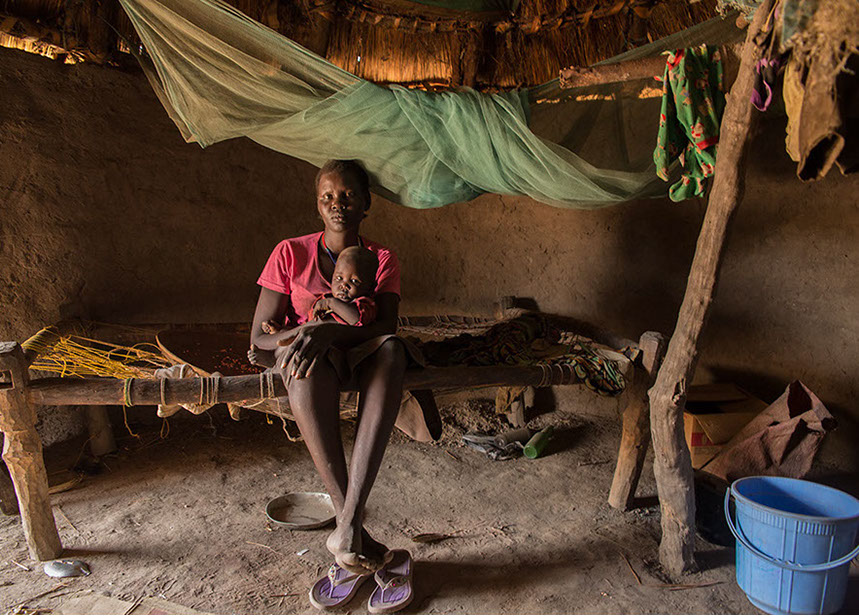
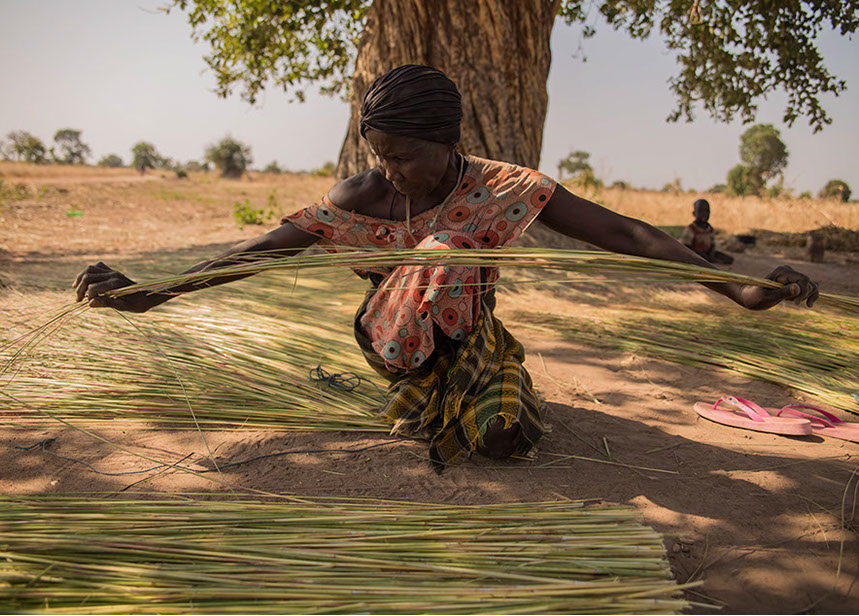
Nyanciech Hiieu stirs a thin vegetable broth in a pot over the fire. (Stefanie Gilinksi/IRIN)
Abuk Moukiir sits in the shade of a tree while harvesting peanuts. She’s sick and weak but survives hunger by finding different day jobs. (Stefanie Gilinksi/IRIN)
Adut Adak sits in her small mud hut. She young mother wasn’t able to harvest this year, but compensates by collecting and selling firewood and by making grass fences. (Stefanie Gilinksi/IRIN)
Many women collect high grass and weave it into fences to sell at the market. They use the little money they make to purchase food for their families. (Stefanie Gilinksi/IRIN)
<
3 - 4
>
The exhausted mother took a gamble, which she hopes will pay off.
“I joined a women’s farming group and it was a big success,” she told IRIN. “We were given tools and were taught how to grow vegetables. All produce was shared between the group’s members.”
She had to spend several weeks in training, with no choice but to leave her children at home under the supervision of her nine-year-old daughter.
“Awel took care of the younger ones and I would cook dinner as soon as I returned home,” said Hiieu.
Awel, with her ripped t-shirt and beaded bracelet, looks way too young to be able to take responsibility for a whole household of children.
“It was sometimes scary, but I knew that if something had happened, I had neighbours close by to call for help,” she explained. “I knew that mum would bring home vegetables for us to eat.”
The family currently survives on two meals of sorghum and dried okra a day. But this will likely fall to one with the progression of the dry season, and there is no money to buy food in the market.
“During the lean season – or hunger gap – [many] cases of malnutrition are observed,” said UN Food and Agriculture Organization nutrition specialist Nicholas Kerandi. “[In] places where food is extremely scarce and disease common, deaths of children often occur.”
The agency runs resilience programmes for farmers in Greater Aweil, including the women’s groups that Hiieu joined, where she receives seeds, tools, and training.
No nutritional value
Adut Adak is only in her mid-twenties and has five children. The family eats little more than a plate of cooked sorghum each day, and she makes sure not a single grain goes to waste.
But as every nutritionist knows, a sorghum-only intake is not sustainable. It may fill the stomach, but it’s not a balanced diet.
“When proteins, vitamins, and minerals are lacking, the immune system will generally tend to weaken and individuals will be susceptible to disease,” FAO’s Kerandi explained. “Most children in sorghum-only areas are malnourished and their diet often affects their growth and can lead to stunting.”
But Adak has little else. Food is boiling over an open fire in her mud hut, wrapping the small room in thick smoke that slowly escapes through the cracks in the thatched roof.
Holding her youngest daughter, Amiir, on her lap, Adak sits on a wooden bed with an old mosquito net hanging over it.
“I’d like for my five children to go to school, but if we ever have money, it will be spent on food,” the young mother explained.
Things were so bad last year she was unable to plant sorghum and has nothing in store. Her husband left a few months ago to live with relatives in Sudan who feed him. She is on her own.
“I spend my mornings collecting firewood to sell in the market and my afternoons making fences out of dried grass. If I don’t sell any of it, my family goes hungry. That’s why I work as hard as I can,” she said quietly.
On a good day, they eat two portions of boiled sorghum, and sometimes Adak finds wild forest fruits, although they also have limited nutritional value.
But giving up is not in the nature of South Sudanese.
“My family might be hungry some days, but next year I will plant sorghum so that I can feed them,” Adak said. “Until then, I will work hard to make sure we have enough to survive.”
x
“I fear that donors, having pushed back the famine, may start to question constantly having to provide greater and greater humanitarian funding to save lives.”
People and governments tend to give more readily in response to natural disasters. The reality is also that some emergencies attract more funding than others.
Excluding flash appeals, some of the worst-funded emergencies in 2017 have been Sudan, Chad, and Burkina Faso. An upsurge in violence in the Democratic Republic of Congo has also caught donors flat-footed.
Tough choices
“There are definitely some countries that are less funded than others – [Congo] stands out as one where overall funding has been low and where Oxfam has also struggled,” said Emily Farr of Oxfam. “Needs are extremely high and money lags behind needs.”
Congo’s looming 2018 catastrophe
Read more
Top humanitarian officials have warned that hundreds of thousands of children could die if food and medical aid don’t reach them
Words and photo by Philip Kleinfeld
Conflict in the Democratic Republic of the Congo is driving a major humanitarian emergency, with 7.7 million people unsure where their next meal will come from.
Fighting in central Kasai and in the eastern provinces of Tanganyika and the Kivus has left 2.5 million people homeless. Forced from their farms and villages, they are unable to farm or fend for themselves.
Clement Tshibola, a 35-year-old pastor in Kasai stayed behind to help bury the dead after government soldiers attacked his commune of Kananga in late March – ostensibly to root out Kamwina Nsapu rebels. He said many people have since returned but face terrible conditions.
“People have nothing to eat,” he told IRIN. “The [army] and Kamwina Nsapu took everything. Cultivating land is possible but people don’t have the money to buy the materials needed [to start farming]. Life is very difficult."
Sylvie Ngalula, 23, fled to Tshikapa, the capital of Kasai, from her home in Lunyeka last year. It took her two weeks navigating through the bush to reach the displacement camp where she and her children survive on just one meal a day.
“We are sick and suffering so often, hungry all of the time,” she said. “We have never lived so badly before.”
Humanitarian operations in Congo are underfunded – donors have financed less than 50 percent of the country’s $812 million aid appeal, despite Congo having being recently declared a Level 3 emergency – the worst-of-the-worst of humanitarian crises.
“The competition between countries to get donors attention, [means] many countries compete for the same pot of money,” said Pierre Bry, Congo country director for CARE.
“The [Congolese] humanitarian community has not been able to reshape their narratives as to explain why the needs are so high and how we can tackle them,” he added.
Find our comprehensive coverage: Crumbling Congo – the making of a humanitarian emergency
Frontline agencies like the World Food Programme are struggling to cope with the scale of the emergency.
WFP chief David Beasley told the BBC in October that “we're talking about several hundred thousand children there that will die in the next few months, if we don't get first funds, and then second food, and then third access in the right locations”.
A WFP emergency operation in Kasai that began in August with an aim of reaching a half million Congolese has been “financed mostly by internal borrowings and advances”, said the agency. A rolling six-month assessment of needs through June 2018 has been less than 10 percent funded.
No peace, less access
The grim reality is that the humanitarian community is failing those in need.
“We are facing severe acute malnutrition,” said Blaise Ingompa, a doctor in Kasai’s Kanzala hospital. People fleeing their villages are arriving in Tshikapa, “but the town doesn’t have enough stock to feed them”.
Aid officials describe a perfect storm of aggravating factors in Congo: in addition to millions of displaced and food insecure, the country has suffered its largest cholera outbreaks in over a decade.
“I believe that all ingredients for a humanitarian catastrophe are looming, and it seems that if the international community does not react promptly it will be too late to avert it,” said Bry.
The conflict helping drive the emergency is unlikely to end soon. A rebellion is underway against President Joseph Kabila, who refused to step down and hold elections in 2016 when his constitutionally mandated two-term limit expired.
“It becomes more and more unbearable for civilians. In the long run, it becomes impossible to escape this violence.”
The ongoing atomisation of armed groups in the country will further complicate the access of aid workers to the vulnerable.
“The more you have fragmentations of armed groups and militia, especially in the east, the more likely it is that there are smaller fights and tensions,” said analyst Christoph Vogel.
“It becomes more and more unbearable for civilians. In the long run, it becomes impossible to escape this violence.”
With additional reporting by Samuel Oakford in New York
(PHOTO: IDPs at a registration centre in Kananga. CREDIT: Philip Kleinfeld/IRIN)
x
Frontline aid agencies like WFP are not yet “at the buffers” of donor support for all their programming needs, said Smerdon. But the pressure to find funding for recurring emergencies means some projects can get starved.
For example, the Dadaab refugee camp in Kenya’s northeast has been open for over 25 years, and has suffered repeated ration cuts.
The latest, a 30 percent reduction, was introduced in November for the 239,000 refugees in Dadaab, as well as the 181,000 refugees in other camps in Kenya.
Read more
Consecutive droughts spell disaster and hunger for Kenya in 2018
Millions are already in need of food aid and the situation is expected to worsen
By Robert Kibet
Two consecutive years of failed rains have left 3.4 million Kenyans in need of food aid and 480,000 children requiring treatment for acute malnutrition. It’s the worst humanitarian crisis the country has faced since a major drought scorched the Horn of African region in 2011, and an emergency likely to persist well into 2018 and beyond.
The government declared a national drought disaster early last year, with 23 out of 47 counties affected. Nutrition surveys showed that perennially dry Turkana North as well as parts of Marsabit and Mandera counties had global acute malnutrition (GAM) rates above 30 percent – double the emergency threshold.
Northern Turkana Central, Turkana South, Turkana West, East Pokot, and Isiolo counties – also in Kenya’s so-called Arid and Semi-Arid Lands, known as ASAL – had GAM rates of between 15 and 29 percent.
Three million people lack access to clean water. Livestock, on which households in the underdeveloped ASAL areas depend, have also succumbed to the water shortages – dying in large numbers.
There has been a market glut as pastoralists have sold off surviving animals, triggering price crashes of as much as 90 percent in some areas.
“Most of the communities we support as an organisation are pastoralists who solely rely on livestock for livelihoods. They lost most of their livestock,” Godfrey Wapangana, a programme officer at the aid agency World Vision, told IRIN.
That has reduced the availability of protein and milk, worsening nutritional levels, particularly among children.
The drought has also hit food production, with maize output falling by 99 percent compared to the long-term average in coastal areas.
That, coupled with an outbreak of the voracious Fall Army Worm pest, has seen wholesale staple food price increases of between eight and 32 percent above average in the urban markets of Nairobi, Mombasa, and Eldoret.
“The last 10 months or so have been one sad moment after another,” said Lojok Lekurug, a 37-year-old mother of six in Nadapal, Turkana County. “With the escalating food prices and the drought, we have been feeding on edible wild fruits, which are scarce. It has not been easy surviving.”
Drought conditions have also led to declines in school attendance and rising dropout rates, UNICEF has warned. Families are also on the move, “which poses protection risks for women and children,” the UN’s emergency aid coordination body, OCHA, noted.
Needs also extend to the 420,000 refugees living in Daadab and Kakuma refugee camps in northern Kenya. Due to a shortfall in funding, the World Food
Programme announced in November that it was cutting rations by 30 percent – just six months after it resumed full rations.
Bad forecast
Some parts of Kenya have faced at least two consecutive years of failed rains leading to the current crisis. And the signs are not good for 2018.
The short rains, typically lasting from October to December, came late and finished early. Pasture and water availability are expected to be below average through the dry season, most likely until the end of March, according to the famine early warning service, FEWSNET.
It forecasts that the long rains (March to May) are still expected to be below average in the currently drought-affected ASAL – although they are expected to be at least average across the western and central areas of the country.
Since November 2016, the government has allocated $124.3 million as part of its response plan. But there are large question marks about the impact of
Kenya’s political uncertainty and re-run elections on further government spending.
In March 2017, the UN launched a $165.7 million flash appeal, followed by a further appeal in August to help scale up the response in northern Kenya. As of
December, out of a total of $205 million requested, donors had provided $86 million – 42 percent of needs.
This shortfall is restricting emergency operations. Despite immense needs, in some counties the WFP has not been able to provide any assistance at all to feed vulnerable children.
The agency also says it has a shortfall of $24.6 million to cover its refugee operation to the end of May 2018.
(PHOTO: Women, children and donkeys on the arid plains at the feet of the Mogila. CREDIT: Gwenn Dubourthoumieu/IRIN)
x
In Rwanda, WFP has been forced to make the first ration cuts since 2012, and may have to make bigger savings in 2018 if funding is not found now for its operations covering 130,000 Burundian and Congolese refugees.
School feeding schemes are currently at risk in Myanmar, Burkina Faso, and Guinea, where school meals work as an incentive for parents to send their children to school, while relieving hunger and malnutrition at home. They help reverse low enrolment and high dropout rates, particularly for girls.
Segregation, distrust, and aid: the politics of food in Myanmar’s Rakhine State
Read more
Food aid has become intensely politicised in Myanmar
By Irwin Loy
Food aid is often political, but in Myanmar’s divided Rakhine State it is firmly entangled in the deep ethnic divisions and ongoing conflict that has pushed hundreds of thousands of Rohingya refugees across the border into Bangladesh.
In a year of escalating violence, the World Food Programme has: seen its aid deliveries suspended; self-censored a controversial report; even been accused of colluding with Rohingya fighters.
These are all good illustrations of the political minefield aid groups must navigate in Rakhine, where food aid is a lifeline but also a root of division that is easily and often exploited for other ends.
Segregation and dependency
International aid groups were enveloped in Rakhine’s discord long before a military crackdown in late August pushed more than 655,000 Rohingya into Bangladesh.
In Rakhine State, Rohingya are widely perceived to be foreigners, despite their long history in the area. Years of government policy stripped them of citizenship and voting rights, slapped severe restrictions on their movement, and squeezed them into isolated villages and camps where they became increasingly – and in many cases, entirely – dependent on international aid.
At the same time, ethnic Rakhine in the state, one of Myanmar’s most impoverished, have long felt marginalised by the national government – and ignored by the international aid groups they see as propping up the Rohingya.
“Many Rakhine view aid groups with deep suspicion, and often resentment,” explained Francis Wade, a journalist and author of the book “Myanmar’s Enemy Within”, which explores the roots of anti-Rohingya sentiment. “There's a belief that aid is being unfairly concentrated on Rohingya, with Rakhine left to fight for whatever scraps the state provides.”
This distrust bubbled over in the aftermath of communal riots in 2012, which saw tens of thousands of Rohingya pushed into barricaded displacement camps in central Rakhine.
The ensuing years have entrenched segregation between the two communities, with Rohingya growing increasingly reliant on aid as their rights have been constricted.
This assistance has only fuelled suspicions among many ethnic Rakhine. In 2014, ethnic Rakhine mobs attacked the offices of aid organisations, forcing several to suspend services.
“The UN and INGOs are on the side of the Bengali,” a prominent monk in Sittwe told an IRIN reporter earlier this year, using a common label in Myanmar implying Rohingya are interlopers from neighbouring Bangladesh.
‘A perilous task’
This backdrop of deep division means the WFP and other aid groups have found themselves having to tiptoe around wary Rakhine community leaders and local authorities, not to mention a national government still perched under the shadow of a military junta that ruled the country for decades.
As tensions simmered in the lead-up to the August 2017 exodus, the WFP published a northern Rakhine food security assessment that confirmed worsening hunger and high levels of child malnutrition fuelled by tightening restrictions. But the WFP soon removed the report from its website, replacing it with a note asking that it “not be cited formally or in any other way”. The WFP later re-published the assessment after media reports questioned the removal.
In late August, as Myanmar’s military launched a devastating crackdown in Rohingya villages, the government released photos of items including WFP-branded food packages it claimed were found in the camps of Rohingya fighters (a government official implied aid groups were involved with the insurgents). Though this was immediately rejected as “absurd” and “irresponsible”, the accusations fed existing resentment among ethnic Rakhine communities. Food aid in the state was cut off, almost entirely.
In the weeks following the August violence, Rakhine communities boycotted aid groups and threatened NGO staff and locals doing business with them.
Wade said aid groups could have done more to emphasise their neutrality over the years but acknowledged that they have also been operating in “acutely difficult conditions”, where many ethnic Rakhine now object to their very presence.
“Aid provision has become a perilous task,” he said.
Months after the August violence, tensions remain as high as ever. Ethnic Rakhine communities have isolated Rohingya villages economically and attempted to block shipments from aid organisations.
The WFP and others have resumed food aid to displacement camps and other communities in central Rakhine, but this is highly dependent on “logistics support” from at times reluctant local authorities.
Humanitarian access has been even more shackled in northern Rakhine, flashpoint of the August violence. The government permitted the WFP to begin limited food distribution in three northern townships only in November. Even this trickle of aid was highly sensitive. According to the EU’s humanitarian aid arm, the food was delivered in plain, unmarked packages – the WFP’s trademark blue-and-white logo pragmatically absent.
(PHOTO: Hasina, 35, and her son, Shahid, 5, who is suffering from severe malnutrition, pictured in the Red Crescent Field Hosptial in Kutupalong. CREDIT: Andrew McConnell/UNHCR)
il/ag
x
These more developmental interventions, like social safety nets and resilience building, are “thinking about the root causes [of crises] rather than just dumping food aid”, explained Veronique Barbelet at the UK-based Humanitarian Policy Group.
For agencies like WFP, a global operation that never has all the money it needs, this endless battle to feed the most needy is a continual triage that helps those it can but inevitably keeps some vulnerable communities almost perpetually at the back of the queue.

Get the inside story
Sign up for our weekly newsletter
Subscribe







